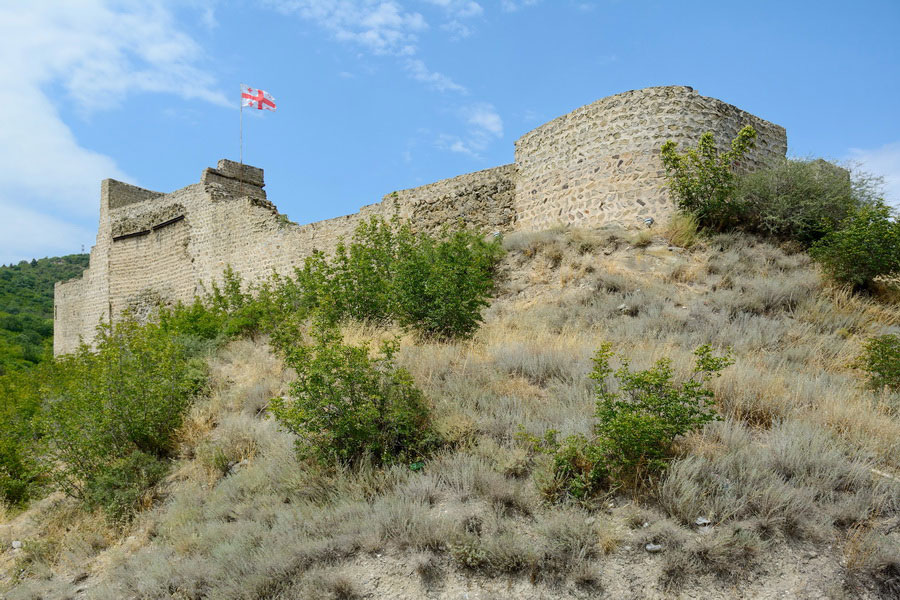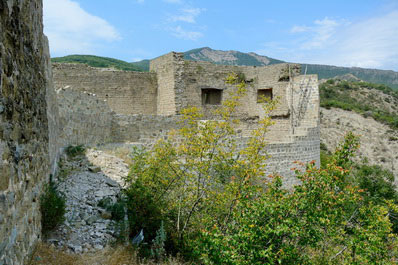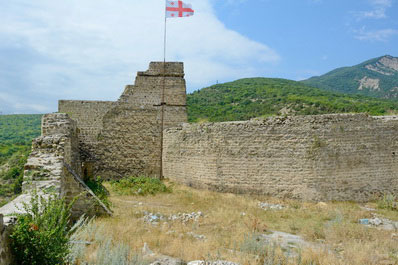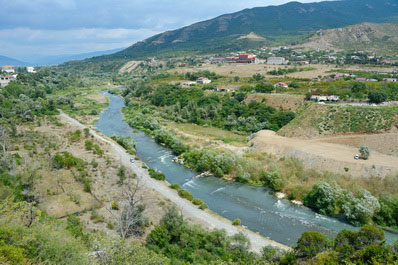 Bebris Tsikhe Fortress near Mtskheta
Bebris Tsikhe Fortress near Mtskheta
Bebris Tsikhe Fortress (Georgian: ბებრის ციხე), previously known as Beltis Tsikhe, is an ancient castle located on the banks of the Aragvi River just north of Mtskheta, Georgia. In 2014 Bebris Tsikhe, whose name translates as “Fortress of an Old Man”, was inscribed on Georgia's Immovable Cultural Monuments of National Significance List.
History of Bebris Tsikhe Fortress
Bebris Tsikhe was erected near an extremely narrow gorge, which made it difficult for the enemy to invade it. It is first mentioned in Georgian writings by a historian of King Lasha-Giorgi. According to the writer, Georgian King Demetre I (1125-1156) died in Beltis Tsikhe, and was subsequently taken to Gelati for burial. 18th-century historian Vakhushti Batonishvili connects the building of Bebris Tsikhe to Arda Eristavi, ruler of Kartli, whose reign coincided with the establishment of the Kingdom of Kartli.
Further materials discovered during excavations of the castle in 2006-2008 reveal that Bebris Tsikhe was an active fortress from the 4th-18th centuries.
The fortress stands atop a mountain and can be seen from kilometers away. Restoration work on Bebris Tsikhe was carried out in 2007-2008. In the spring of 2010, it was severely damaged in a landslide, and in summer 2020, reconstruction of the castle began again. Nonetheless, visitors are still welcome to visit Bebris Tsikhe Fortress and enjoy its picturesque view of the Aragvi River Valley.
Architecture of Bebris Tsikhe Fortress
Bebris Tsikhe, like many fortresses in Georgia, is located on a high, remote rocky massif. Archeologists have unearthed ancient and feudal layers within its walls. Its foundation is triangular and consisted of a central fortress with an outer courtyard, turrets and defensive watchtowers which capped all three edges of the citadel. The fact that Demetre I died in the fort also suggests that the castle served as a royal residence. The total area of the fortress equates to approximately 1500 square meters, while the inner courtyard is about 600 square meters.
Legend of Bebris Tsikhe Fortress
According to legend, Bebris Tsikhe was constructed in a narrow stretch of ravine by a prince called Simon. Simon had two children: a very kind daughter named Makrine and a cruel son named Mamuka.
After the death of their father, Mamuka imposed such an enormous tax on the people that they were unable to pay. Makrine begged him to show mercy, but Mamuka paid no heed to his sister’s plea and instead imprisoned her in one of the towers of Beltis Tsikhe. Once, while the peasants were making watery meals in a huge pot, crows unexpectedly flew into the pot and were boiled, forcing the peasants to discard the meal. When Mamuka heard about it, he was furious and about to punish them severely. At that very moment, however, snakes emerged from the pot and coiled around him. Mamuka begged God to release him from the snakes, promising he would build a church if his prayer was answered. Meanwhile, Makrine was also praying that God would save her brother.
Mercifully, God set Mamuka free from the snakes. In gratefulness, Mamuka gave away his fortune, became a monk and began to collect donations for the construction of a church. His sister Makrine likewise became a nun. When Makrine died in her 70s, a white-bearded old man came to her funeral, kissed the deceased and said: ″My sister, we kept our promise″. As soon as he pronounced the words, Mamuka died. Ever since, the fortress has been called ″Bebris Tsikhe″ (Fortress of an Old Man).
Visiting Bebris Tsikhe Fortress
If you are in Mtskheta, a visit to ancient Bebris Tsikhe is sure to enhance your travels. You can enjoy a bit of peace and quiet at the fort, along with great views. Bebris Tsikhe Fortress can be reached on foot in just half an hour from Svetitskhoveli Cathedral, or by car in just a few minutes. Parking is available nearby.




